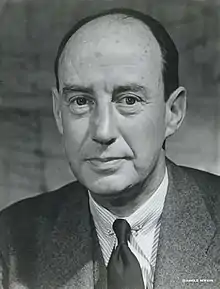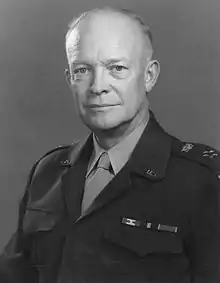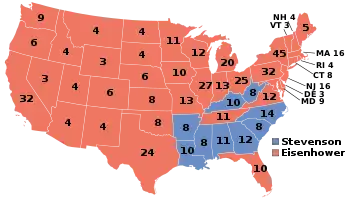1952 United States presidential election in South Carolina
The 1952 United States presidential election in South Carolina took place on November 4, 1952, as part of the 1952 United States presidential election. South Carolina voters chose 8[3] representatives, or electors, to the Electoral College, who voted for president and vice president.
| ||||||||||||||||||||||||||
All 8 South Carolina votes to the Electoral College | ||||||||||||||||||||||||||
|---|---|---|---|---|---|---|---|---|---|---|---|---|---|---|---|---|---|---|---|---|---|---|---|---|---|---|
| ||||||||||||||||||||||||||
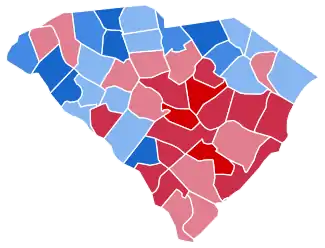 County Results
| ||||||||||||||||||||||||||
| ||||||||||||||||||||||||||
| Elections in South Carolina |
|---|
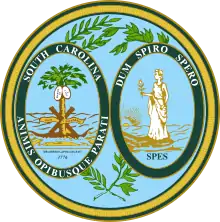 |
Background
For six decades up to 1950, South Carolina had been a one-party state dominated by the Democratic Party. The Republican Party had been moribund due to the disfranchisement of blacks and the complete absence of other support bases as the Palmetto State completely lacked upland or German refugee whites opposed to secession.[4] Between 1900 and 1948, no Republican presidential candidate ever obtained more than seven percent of the total presidential vote[5] – a vote which in 1924 reached as low as 6.6% of the total voting-age population[6] (or approximately 15% of the voting-age white population).
This absolute loyalty began to break down during World War II when Vice-Presidents Henry A. Wallace and Harry Truman began to realize that a legacy of discrimination against blacks was a threat to the United States' image abroad and its ability to win the Cold War against the radically egalitarian rhetoric of Communism.[7] In the 1948 presidential election, Truman was backed by only 24% of South Carolina's limited electorate – most of that from the relatively few upcountry poor whites able to meet rigorous voting requirements – and state Governor Strom Thurmond won 71%, carrying every county except Anderson and Spartanburg.
Sweeping changes in electorate
Between the 1948 and 1952 presidential elections, South Carolina's electorate saw the most radical changes in any state since Reconstruction and "Redemption" had expanded and then contracted the electorates of all former Confederate states. The state became the last to fully adopt the secret ballot, whose absence had allowed intimidation of those who refused to vote Democratic in general elections,[8] and it also fully abolished the poll tax that had further restricted white turnout in presidential elections.[8] There was also some expansion of black voter registration, though as in all areas of the South east of the Mississippi River this was largely an urban phenomenon.
Continuing sentiment against national Democrats
Despite Truman announcing as early as May 1950 that he would not run again for President in 1952,[9] it had already become clear that South Carolina's rulers remained severely disenchanted with the national Democratic Party.[10] Originally it was planned that Eisenhower would run on an independent ticket with former state Governor James F. Byrnes,[10] who regained his Senate seat in the 1950 primary, with the ultimate goal of the entire South controlling national politics as an unpledged electoral slate.
Despite some criticism of his policies, Byrnes created an organization named "Independents for Eisenhower" which was aimed at allowing white Southerners to leave the Democratic Party without embracing the still-feared "Party of Lincoln".[11] These would join with a small number of remnant Republicans to form a fusion slate for Eisenhower – who by the time this plan was developed in September had already won the Republican nomination. In addition to Byrnes, Dixiecrat candidate Thurmond also endorsed Eisenhower,[12] foreshadowing his switch to the Republican Party to support the much more conservative Barry Goldwater a dozen years later.
Further sentiment against the national Democratic Party resulted from fears that the Supreme Court would – as it did in the legendary Brown v. Board of Education case a year and a half after the election – rule South Carolina's de jure segregated school system a violation of the Fourteenth Amendment.[13]
Vote
From the time Eisenhower announced he would run on an independent slate nominated by the many dissident Democrats, he gained substantial support, most especially in the small black-majority rural counties where only whites voted.[14] However, polls always had Stevenson staying ahead of Eisenhower, and in the end he carried the state by a small majority of 5,000 votes. Stevenson's victory was largely due to his ability to maintain two- and three-to-one majorities in the poor white upcountry counties that had given substantial opposition to Thurmond,[15] along with a substantial majority of the 20,000 or so blacks who are believed to have voted.[16]
The Palmetto State was ultimately won by Stevenson and running mate Alabama Senator John Sparkman, with 50.72% of the popular vote, against Columbia University President Eisenhower (R–New York) and California Senator Richard Nixon, with 49.28% of the popular vote.[17][18] As of the 2020 presidential election, this is the last election in which Aiken County voted for a Democratic presidential candidate.
Results
| Party | Candidate | Votes | % | |
|---|---|---|---|---|
| Democratic | Adlai Stevenson | 173,004 | 50.72% | |
| Independent | Dwight D. Eisenhower | 168,082[lower-alpha 1] | 49.28% | |
| Total votes | 341,086 | 100% | ||
Results by county
| County | Adlai Stevenson II Democratic |
Dwight David Eisenhower "Nominated by Petition"/Republican[lower-alpha 1] |
Margin | Total votes cast[19] | |||
|---|---|---|---|---|---|---|---|
| # | % | # | % | # | % | ||
| Abbeville | 2,776 | 74.11% | 970 | 25.89% | 1,806 | 48.21% | 3,746 |
| Aiken | 4,346 | 50.37% | 4,282 | 49.63% | 64 | 0.74% | 8,628 |
| Allendale | 440 | 36.94% | 751 | 63.06% | -311 | -26.11% | 1,191 |
| Anderson | 11,664 | 77.75% | 3,338 | 22.25% | 8,326 | 55.50% | 15,002 |
| Bamberg | 750 | 34.77% | 1,407 | 65.23% | -657 | -30.46% | 2,157 |
| Barnwell | 1,598 | 70.86% | 657 | 29.14% | 941 | 41.73% | 2,255 |
| Beaufort | 1,106 | 40.89% | 1,599 | 59.11% | -493 | -18.23% | 2,705 |
| Berkeley | 1,708 | 40.76% | 2,482 | 59.24% | -774 | -18.47% | 4,190 |
| Calhoun | 384 | 25.75% | 1,107 | 74.25% | -723 | -48.49% | 1,491 |
| Charleston | 9,959 | 33.15% | 20,087 | 66.85% | -10,128 | -33.71% | 30,046 |
| Cherokee | 5,545 | 78.39% | 1,529 | 21.61% | 4,016 | 56.77% | 7,074 |
| Chester | 2,843 | 50.59% | 2,777 | 49.41% | 66 | 1.17% | 5,620 |
| Chesterfield | 4,668 | 72.44% | 1,776 | 27.56% | 2,892 | 44.88% | 6,444 |
| Clarendon | 953 | 31.49% | 2,073 | 68.51% | -1,120 | -37.01% | 3,026 |
| Colleton | 1,905 | 40.84% | 2,760 | 59.16% | -855 | -18.33% | 4,665 |
| Darlington | 5,718 | 62.28% | 3,463 | 37.72% | 2,255 | 24.56% | 9,181 |
| Dillon | 1,578 | 51.72% | 1,473 | 48.28% | 105 | 3.44% | 3,051 |
| Dorchester | 852 | 26.87% | 2,319 | 73.13% | -1,467 | -46.26% | 3,171 |
| Edgefield | 753 | 31.14% | 1,665 | 68.86% | -912 | -37.72% | 2,418 |
| Fairfield | 1,590 | 49.73% | 1,607 | 50.27% | -17 | -0.53% | 3,197 |
| Florence | 5,340 | 50.49% | 5,236 | 49.51% | 104 | 0.98% | 10,576 |
| Georgetown | 1,370 | 36.93% | 2,340 | 63.07% | -970 | -26.15% | 3,710 |
| Greenville | 14,863 | 45.58% | 17,743 | 54.42% | -2,880 | -8.83% | 32,606 |
| Greenwood | 3,815 | 52.93% | 3,392 | 47.07% | 423 | 5.87% | 7,207 |
| Hampton | 787 | 32.52% | 1,633 | 67.48% | -846 | -34.96% | 2,420 |
| Horry | 4,489 | 54.71% | 3,716 | 45.29% | 773 | 9.42% | 8,205 |
| Jasper | 636 | 44.29% | 800 | 55.71% | -164 | -11.42% | 1,436 |
| Kershaw | 2,052 | 41.15% | 2,935 | 58.85% | -883 | -17.71% | 4,987 |
| Lancaster | 4,989 | 61.83% | 3,080 | 38.17% | 1,909 | 23.66% | 8,069 |
| Laurens | 3,697 | 52.09% | 3,400 | 47.91% | 297 | 4.18% | 7,097 |
| Lee | 927 | 35.71% | 1,669 | 64.29% | -742 | -28.58% | 2,596 |
| Lexington | 3,513 | 46.65% | 4,018 | 53.35% | -505 | -6.71% | 7,531 |
| Marion | 1,610 | 41.04% | 2,313 | 58.96% | -703 | -17.92% | 3,923 |
| Marlboro | 1,699 | 52.44% | 1,541 | 47.56% | 158 | 4.88% | 3,240 |
| McCormick | 624 | 51.91% | 577 | 48.00% | 47 | 3.91% | 1,202[lower-alpha 2] |
| Newberry | 3,418 | 45.31% | 4,126 | 54.69% | -708 | -9.38% | 7,544 |
| Oconee | 3,230 | 66.54% | 1,624 | 33.46% | 1,606 | 33.09% | 4,854 |
| Orangeburg | 2,829 | 37.60% | 4,695 | 62.40% | -1,866 | -24.80% | 7,524 |
| Pickens | 2,865 | 48.06% | 3,096 | 51.94% | -231 | -3.88% | 5,961 |
| Richland | 8,890 | 35.83% | 15,925 | 64.17% | -7,035 | -28.35% | 24,815 |
| Saluda | 1,592 | 53.28% | 1,396 | 46.72% | 196 | 6.56% | 2,988 |
| Spartanburg | 21,883 | 68.58% | 10,028 | 31.42% | 11,855 | 37.15% | 31,911 |
| Sumter | 2,014 | 29.88% | 4,726 | 70.12% | -2,712 | -40.24% | 6,740 |
| Union | 5,921 | 73.87% | 2,094 | 26.13% | 3,827 | 47.75% | 8,015 |
| Williamsburg | 1,320 | 33.88% | 2,576 | 66.12% | -1,256 | -32.24% | 3,896 |
| York | 7,495 | 58.66% | 5,281 | 41.34% | 2,214 | 17.33% | 12,776 |
| Totals | 173,004 | 50.72% | 168,082 | 49.28% | 4,922 | 1.44% | 341,086 |
Notes
- Eisenhower vote was the fusion of 158,289 votes for "Independent" or "Nominated by Petition" electors and 9,793 "Republican" electors
- One write-in vote was recorded from McCormick County
References
- "United States Presidential election of 1952 - Encyclopædia Britannica". Retrieved July 25, 2017.
- "U.S. presidential election, 1952". Facts on File. Archived from the original on October 29, 2013. Retrieved October 24, 2013.
Eisenhower, born in Texas, considered a resident of New York, and headquartered at the time in Paris, finally decided to run for the Republican nomination
- "1952 Election for the Forty-Second Term (1953-57)". Retrieved July 25, 2017.
- Phillips, Kevin P.; The Emerging Republican Majority, pp. 208, 210 ISBN 9780691163246
- Mickey, Robert; Paths Out of Dixie: The Democratization of Authoritarian Enclaves in America's Deep South, 1944-1972, p. 440 ISBN 0691149631
- Mickey; Paths Out of Dixie, p. 27
- Fredericksen, Karl A.; The Dixiecrat Revolt and the End of the Solid South, p. 52 ISBN 0807849103
- Mickey; Paths Out of Dixie, p. 233
- Truman, Harry S.; President Harry S. Truman's Office Files, 1945-1953, p. 30 ISBN 1556551533
- Bedingfield, Sid, 'Beating Down the Fear: The Civil Sphere and Political Change in South Carolina, 1940-1962', University of South Carolina Dissertations, 2014, p. 139
- Bedingfield, 'Beating Down the Fear', p. 170
- Mayer, Michael S.; The Eisenhower Years, p. 767 ISBN 1438119089
- Kalk, Bruce H.; The Origins of the Southern Strategy: Two-Party Competition in South Carolina, 1950-1972, pp. 18-20 ISBN 0739102427
- 'Press Survey Indicates S.C. Will Vote Democratic in November'; The Index-Journal, September 17, 1952, p. 16
- Strong, Donald S.; 'The Presidential Election in the South, 1952,' The Journal of Politics, vol. 17, no. 3 (August 1955), pp. 343-389.
- Bedingfield, 'Beating Down the Fear', p. 164
- "1952 Presidential General Election Results - South Carolina". Retrieved July 25, 2017.
- "The American Presidency Project - Election of 1952". Retrieved July 25, 2017.
- Scammon, Richard M. (compiler); America at the Polls: A Handbook of Presidential Election Statistics 1920-1964; p. 397 ISBN 0405077114
